4:00 P.M.
by David J. Baylink M.D.
Assembly Room, A. K. Smiley Public Library
Dr. David Baylink is Distinguished Professor of Medicine, Biochemistry, Orthopedic
Surgery, Oral Surgery, and Pediatrics at Loma Linda University and Chief, Mineral
Metabolism at the Pettis Veterans Administration Medical Center. His Mineral Metabolism
Laboratory, with over 50 employees, is one of the largest of its kind in the world.
Dr. Baylink has served on editorial boards of many scientific journals and has received
many awards for his research accomplishments. For example, he has been elected to two
prestigious clinical scientific societies, the American Society for Clinical Investigation
and the American Association of Physicians. In 1996, he was the mentor to his son, Timothy
Baylink, a second-year medical student, who receded the Medical Student Basic Science
Award at Loma Linda University. Dr. Baylink has published over 400 full-length papers and
over 600 abstracts. He has trained more than 50 postdoctoral fellows from the United
States, South America, Western and Eastern Europe and several countries in Asia.
Dr. Baylink and his wife, Colleen, have three children and one grandchild.
This paper begins with an imaginary conversation between a silly housewife and a doctor
in a New Age clinic, where the silly housewife describes the changes she would like to
have made in the genome of her embryo daughter. She makes ridiculous requests to increase
her daughter's I.Q., to change the shape of her nose, and even her disposition, so she
won't keep her mother awake at night. This imaginary conversation would not have been
possible if it had not been for the seminal advance of two University of California, San
Francisco, molecular biologists, Stanley Cohen and Herbert Boyer, who created the first
recombinant genetic material. They produced a hybrid creature that was part bacterium and
part frog. This experiment in itself had no practical value, but it demonstrated to other
scientists that it was possible to engineer the genome. Since that time, genetic
engineering advances have been mind-boggling. The development of molecular techniques have
allowed scientists to engineer genes in or out of a given genome and create miracles in
molecular biology. For example, diabetics are now treated with recombinant human insulin,
which is produced by bacteria but, yet, is identical to the human insulin produced by the
human pancreas. Genetic engineering has progressed to the point that some children with
specific diseases have been cured by correcting the genetic defect by introducing a normal
copy of a mutated gene into children with genetic diseases. Also an advance of the genetic
engineering age is the use of DNA fingerprinting for forensic and other purposes. Large,
important advances have also been made in agriculture by genetic engineering. Plants have
been genetically engineered to be resistant to herbicides, making agriculture less labor
intensive. Cotton has been produced with longer and stronger cotton fibrils. The genetic
engineering age has culminated in the cloning of a sheep called Dolly. After 277 cloning
attempts, Dolly is the first successful cloning of a mammal. Genetic engineering provides
the means to produce enormous advances in the fields of medicine and agriculture, advances
which can improve the health and nutrition of the world's population.
Let us develop an appreciation for the impact of genetic engineering on us by going
back twenty-four years to when this revolution in biotechnology began.
In 1973, two biochemists at the University of California, San Francisco, Stanley Cohen
and Herbert Boyer, constructed a hybrid creature that was part bacterium and part frog.
(They used bacteria, because bacteria have simple genomes.) They used frogs, because they
wanted to show that bacteria could be induced to express gene products from a
multicellular organism.
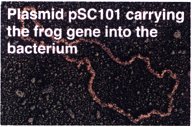
Slide 1: This slide shows plasmid PSC101 carrying the frog gene in a bacterium.
(Plasmid is a piece of circular DNA; DNA is deoxyribonucleic acid, which is the building
block for genetic material.) This is an electronmicrograph, which magnifies thousands of
times. This circular structure is a bacterial plasmid. Inserted into this bacterial
plasmid is a frog gene. Incidentally, P stands for plasmid and SC stands for Stanley Cohen
and 101 is the number of plasmids produced in this lab.
Construction of recombinant DNA
Slide 2: The next slide shows, in more graphic detail, how this plasmid, from the
bacterium, was altered to
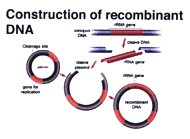
incorporate a gene from a frog. At the left is plasmid Stanley Cohen #101. At the
right-hand top is the gene from Xenopus, which will be inserted into the bacterial
plasmid. (Xenopus is the scientific name for a frog.) A certain enzyme is used to cleave
the bacterial plasmid and open up the ring, as illustrated here. The same enzyme is
utilized to dissect out the gene from Xenopus, which is then inserted into the bacterial
plasmid. This process closes the circular confirmation of the bacterial plasmid, and the
result is what is now referred to as recombinant DNA. In other words, the Xenopus DNA, or
the Xenopus gene, is now combined with bacterial DNA from E-coli. Escherichia cold is the
gram-negative bacterium present in the lower GI tract of all mammals. This recombinant
bacteria carrying the frog gene proceeded to express, along with its normal repertoire of
bacterial genes, a frog gene as well. (Recombinant is when DNA from one source is
recombined with DNA from another source; gene expression refers to production of the
protein encoded by the gene.) Never before had such a genetically altered organism
existed.
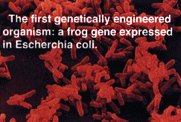
Slide 3: This is an electronmicrograph of the first genetically engineered organism
produced by Bayer and Cohen in 1973. As mentioned earlier, these bacteria contain a frog
gene.
On the basis of this pioneering work, a new science has developed called genetic
engineering. Genetic engineering constitutes the ability to manipulate DNA to the extent
that it can be cut, rearranged, or amplified, and then inserted into another organism.
Recombinant DNA technology is possible because of the universality of the genetic code
among organisms as diverse as bacteria, elephants, and pine trees. Thus, organisms
classified in different kingdoms have the same gene chemistry code. (Genetic code refers
to the sequence of nucleotides; nucleotides are chemical molecules containing
deoxyribonucleic acid; these are the building blocks of genes.)
I would now like to return to the subject of biotechnological advances in medicine. In
1982, the U.S. Food and Drug Administration approved the use of the first genetically
engineered medicine, namely, recombinant human insulin. Recombinant human insulin is made
by bacteria. When we think of bacteria, we think of disease, illness, bad smells, waste,
and tonsillitis. However, biotechnology has harnessed the metabolic activity of bacteria
to produce medicines for humans. In the past, diabetes was treated with pork insulin.
(Diabetes is a disease where there is an abnormality of sugar metabolism.) The insulin was
purified from the pancreas of pigs. One disadvantage of pork insulin was that some humans
were allergic to pork insulin, because it is not chemically identical to human insulin.
However, the insulin that is made by the bacteria is made with the human gene and,
therefore, the insulin made by the bacteria is chemically identical to the insulin made by
the human pancreas. Furthermore, it is much cheaper to make human insulin by genetic
engineering than it is to extract porlc insulin and purify it from pork pancreas.
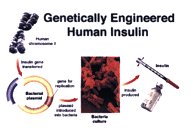
Slide 4: This slide shows how large amounts of insulin can be obtained through genetic
engineering.
On the left of this slide you see human chromosome #2. (Chromosomes are organelles in
the nucleus that contain the genes.) The gene for insulin is cut out of chromosome #2 by
specific restriction enzymes and inserted into a bacterial plasmid, as illustrated. The
bacteria containing this plasmid then produce insulin, which can be separated from other
bacterial proteins to treat diabetes. The bottom left shows the insulin gene being
inserted into the bacterial plasmid. The plasmid is then inserted into the bacteria, in
this case Escherichia coli. A culture of these bacterial rods is shown in the middle of
the slide. The broth from these bacteria contains insulin. The insulin is purified by
special techniques and is then used to treat patients with diabetes. E-coli cultures crank
out millions of molecules of insulin. This is a much more efficient process than purifying
insulin from pork pancreas.
Other products produced by genetic engineering and used in human medicine include
proteins to dissolve blood clots; growth factors that stimulate white blood cell
production; erythropoietin, which stimulates the production of red blood cells; human
growth hormone for the treatment of short stature; interferons and interleukins, which are
used in the treatment of viral diseases and some cancers; monoclonal antibodies, which are
used to deliver cancer drugs to specific cancerous cells, and many other factors.
Thus far, we've talked about making medicines by genetic engineering, but what about
altering the genome, as in the case of Mrs. Calabash's unborn daughter? In 1990, the first
attempt was made to use genetic engineering to combat genetic disorders.
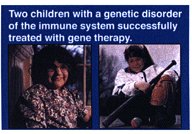
Slide 5: This slide shows two children with a genetic disorder of the immune system
successfully treated with gene therapy. These two girls suffered from an immune disorder
requiring each of them to live in a microbe-free bubble because of a defective gene of the
immune system. Doctors extracted bone marrow cells from the girls and replaced the
defective gene with a normal gene. These genes were then returned to the girls' bone
marrow, where they began to produce a normal immune protein. Both girls are now well and
healthy and living normal lives outside, the sanitized bubble.
Sometimes, the trickiest part about gene therapy is getting the plasmid DNA into the
host cell. Recently, an instrument called the gene gun was developed to actually shoot the
gene into the host cells.
Slide 6: This slide shows how the gene gun could be used for gene therapy for bone
diseases.
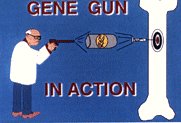
Thus far, we have mentioned that biotechnology has made advances in medicine. Another
area where advances have been made is forensic work. The first time police used DNA
fingerprinting on a murder suspect, the test cleared an innocent man of the charges. (DNA
fingerprinting is not really a fingerprint but, rather, a metaphor for fingerprinting; DNA
fingerprinting is a molecular technique to show differences in DNA structure, which are
unique to a given individual.) In 1986, police in Narborough, England were convinced that
a suspect had committed two murders. The suspect had even confessed to one of the murders.
However, DNA fingerprinting proved that he had not committed either murder. Police had
collected and tested blood samples from every possible suspect, which included more than
4,500 men in
Sometimes, the trickiest part about gene therapy is getting the plasmid DNA into the
host cell. Recently, an instrument called the gene gun was developed to actually shoot the
gene into the host cells Narborough and a nearby town. The DNA fingerprinting identified
the real murderer, who was convicted of both murders.
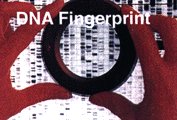
Slide 7: This slide shows DNA from several individuals cut with an enzyme to generate a
mixture of DNA fragments which are then separated by gel electrophoresis. (Gel
electrophoresis is the technique that is used to separate the fragments of DNA based on
their size; different individuals show different patterns.) (The bands consisting of the
largest DNA fragments move at the slowest rate and, thus, are found at the top of the
gel.) Each column represents a different individual. Because the genetic make up of each
individual is different, you see here different DNA fragment patterns among different
individuals. By analyzing the size and the intensity of the bands, one can establish the
identity of the individual.
It is extremely unlikely that any two unrelated people would have exactly the same DNA
fragment pattern on gel electrophoresis. Thus, DNA fingerprinting can provide indisputable
evidence of identity. As of now, there are no uniform government-supervised standards for
DNA testing and, thus, DNA tests are often challenged in court as unreliable.
DNA fingerprinting techniques can be applied to different biological specimens,
including blood, semen, bone, and hair.
Slide 8: How can genetic engineering be used to the advantage of agriculture?
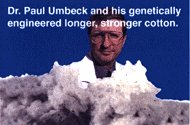
This slide shows Dr. Paul Umbeck and his genetically engineered longer, stronger,
cotton fibrils.
Another big breakthrough in agriculture has been to develop crop plants that are
resistant to the herbicide glyphosate, a powerful biodegradable weed killer. Glyphosate
kills most actively growing plants by destroying an enzyme needed by the plants.
The trick was to have the herbicide glyphosate kill off the weeds but not the crop
plants. To do this, genetic engineers found bacteria that made this enzyme even in the
presence of glyphosate. Genetic engineers then introduced this glyphosate-resistant gene
into crop plants. This gene was introduced into soy beans by a special genetic engineering
method.
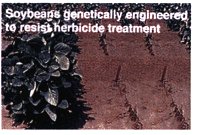
Slide 9 This slide shows soy beans genetically engineered to resist herbicide
treatment. On the left, you can see soy bean plants that have been treated by glyphosate.
They show no ill effects from this herbicide treatment. The dead or dying remains of soy
bean plants not genetically engineered to resist this herbicide are shown on the right.
The genetically engineered soy bean crops now do not need to be weeded. Instead, the
farmer simply treats the field with glyphosate. All growing plants die except the crop,
which is resistant to glyphosate. Glyphosate is quickly broken down in the environment
and, thus, is a big improvement over most herbicides.
Another big advantage of this whole process relates to one of the biggest problems in
agriculture -- the loss of fertile topsoil to erosion. The current program of herbicide
resistant crops should markedly decrease this erosion, since, without weeds, it is
unnecessary to intensively cultivate croplands, and, as a result, there will be less
erosion.
In addition to many advances in agricultural crops, genetic engineering has resulted in
agricultural advances in livestock production. For example, the size of beef cattle has
been increased as a result of genetic engineering. In addition, agriculture and medicine
have combined forces to produce what is called a transgenic animal. Such transgenic
animals have been used to make medicines.
Slide 10: This slide shows a transgenic sow that produces protein C in her milk. By a
special genetic

engineering technique, the Protein C is only made by milk-producing cells. Human
protein C is an anti-thrombotic protein that is used in coronary bypass surgery to reduce
bleeding and, thus, the amount of donor blood needed. It is much cheaper to produce
therapeutics in livestock by this transgenic means than by bacteria.
Slide 11: In addition to making transgenic animals, one can apply genetic engineering
techniques to clone animals. In fact, the cloning of Dolly, a sheep in Scotland, made
headlines
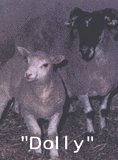
throughout the entire world. (Clone means genetically identical.) This slide shows a
photograph of young Dolly with her surrogate mother.
Dolly doesn't look like her mother, because she is genetically a clone from another
sheep and is genetically unrelated to her birth mother.
Slide 12: This slide illustrates the strategy that made Dolly. The first step is to
perform in vitro fertilization. The Scottish doctors,lead by Ian Wilmut, first removed
cells from the udder of one ewe. Next, they obtained an
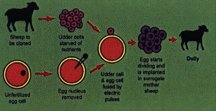
unfertilized egg from another ewe and removed t e nucleus from this unfertilized egg.
The third step was to fuse the udder cell, which contained DNA, with the unfertilized egg,
which did not contain DNA, because the nucleus had been removed. This fusion, in effect,
produced a fertilized ovum, which contained only genetic from the ewe that provided the
War cell. This ovum was then placed in the uterus of a third ewe, the surrogate mother.
The surrogate mother later gave birth to Dolly, which represents a clone of the ewe that
supplied the udder cell.
This sounds like a simple procedure, but it is far more complicated than I have
depicted. In actual fact, in order to make Dolly, 277 cloning attempts were required. The
advantage to cloning an animal, from an agricultural standpoint, is that, in each herd of
animals, there are always a few animals that stand out as being superior to others, either
in milk production, as in the case of dairy cattle, or in beef production, as in the case
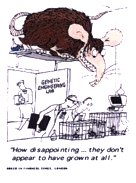
of beef cattle. With cloning, one can take the best animal of the herd and make several
clones of this animal and thereby improve the overall quality of the herd.
Slide 13: This slide illustrates the types of experiments being done in a genetic
engineering laboratory. "How disappointing-they don't appear to have grown at
all."
In conclusion, genetic engineering provides the means to produce enormous advances in
the fields of medicine and agriculture that can improve the health and nutrition of the
world’s population, provided Mrs. Calabash and her neighbor agree.